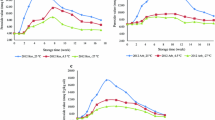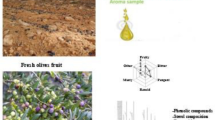Abstract
The extra virgin olive oil (EVOO) has a certain oxidation resistance when compared to other vegetable oils without refining process, due to their large composition of monounsaturated fatty acids, antioxidants, and bio-compounds. The main of this research was to evaluate and monitor the behavior of autoxidative processes through the storage time in two packaging systems of different EVOO monovarietals produced in Minas Gerais, Brazil by using ultraviolet and visible spectroscopy (UV–Vis) with multivariate curve resolution with alternating least squares (MCR–ALS). We analyzed six EVOOs produced from different monovarietals (Arbequina, Empeltre, Coratina, Grappolo, Koroneiki, and Maria da Fé), over the course of 1 year, performed the analysis in times 0, 30, 90, 180, and 365 days, and storage in glass bottles and tinplate cans. The UV–Vis spectroscopy coupled with MCR–ALS was a feasible tool to monitor autoxidation processes in EVOO through storage time and in the monitoring of the EVOO quality in different package systems. The glass bottles were a package system that provides more protection for the autoxidation processes with the time for the EVOO from monovarietals Empeltre, Arbequina, and Coratina. In addition, it was possible to make a differentiation between the monovarietal olive oils produced in Brazil by observing the amount of phenolic compounds present in the chemical composition of each oil. Allowing gather information about the formation of oxidative products may correlate with the shelf life of the EVOO.




Similar content being viewed by others
References
Acharya D, Rani A, Agarwal S, Singh V (2016) Application of adaptive Savitzky-Golay filter for EEG signal processing. Perspect Sci 8:677–679. https://doi.org/10.1016/j.pisc.2016.06.056
Alvarenga AA, Cruz JL, Oliveira AF, Silva LFO, Gonçalves ED, Norberto PM (2017) Nutritional quality of olives and olive oil produced in the Serra da Mantiqueira from Brazil. Agric Sci 8(07):518–526. https://doi.org/10.4236/as.2017.87039
Andreou V, Dimopoulos G, Alexandrakis Z, Katsaros G, Oikonomou D, Toepfl S, Heinz V, Taoukis P (2016) Shelf-life evaluation of virgin olive oil extracted from olives subjected to nonthermal pretreatments for yield increase. Innovative Food Sci Emerg Technol 40:52–57. https://doi.org/10.1016/j.ifset.2016.09.009
Aparício R, Luna G (2002) Characterisation of monovarietal virgin olive oils. Eur J Lipid Sci Technol 104(9-10):614–627. https://doi.org/10.1002/1438-9312(200210)104:9/10<614::AID-EJLT614>3.0.CO;2-L
Ballus CA, Quirantes-Piné R, Bakhouche A, da Silva LFO, de Oliveira AF, Coutinho EF, da Croce DM, Segura-Carretero A, Godoy HT (2015) Profile of phenolic compounds of Brazilian virgin olive oils by rapid resolution liquid chromatography coupled to electrospray ionization time-of-flight mass spectrometry (RRLC-ESI-TOF-MS). Food Chem 170:366–377. https://doi.org/10.1016/j.foodchem.2014.08.054
Bendini A, Cerretani L, Salvador MD, Fregapane G, Lercker G (2010) Stability of the sensory quality of virgin olive oil during storage an overview. Ital J Food Sci 21:389–406
Bertoncini AI (2012)Cultivo de oliveiras no estado de São Paulo. Pesquisa & Tecnologia 9:1–10
Borrás E et al (2016) Prediction of olive oil sensory descriptors using instrumental data fusion and partial least squares (PLS) regression. Talanta 155:116–123. https://doi.org/10.1016/j.talanta.2016.04.040
COI/T.15/NC No 3/REV. 6 – International Olive Council (IOC) (2015) Trade standard applying to olive oils and olive-pomace oils. Madrid, Spain.
Craft NE (2016) Tocopherols: properties and determination. In: Cabellero B, Finglas PM, Toldrá F (eds) Encyclopedia of food and health, 1st edn. Elsevier, Oxford, pp 309–318
Curti SMM, Ritter CM, da Silva LB, Valderrama L, Barriquello Consolin MF, Consolin Filho N, Medeiros FVS, Março PH, Valderrama P (2017) On the feasibility of spectroscopy and curve resolution to detection of ethinylestradiol in sewage—preliminary studies. Br J Anal Chem 4:35–39
Dabbou S et al (2010) Extra virgin olive oil components and oxidative stability from olives grown in Tunisia. J Am Oil Chem Soc 87:1199–1209. https://doi.org/10.1007/s11746-010-1600-3
Dias LG, Fernandes A, Veloso ACA, Machado AASC, Pereira JA, Peres AM (2014) Single-cultivar extra virgin olive oil classification using a potentiometric electronic tongue. Food Chem 160:321–329. https://doi.org/10.1016/j.foodchem.2014.03.072
Frankel EN (2010) Chemistry of extra virgin olive oil: adulteration, oxidative stability, and antioxidants. J Agric Food Chem 58:5991–6006. https://doi.org/10.1021/jf1007677
Gonçalves R, Março PH, Valderrama P (2014a) Thermal edible oil evaluation by UV-Vis spectroscopy and chemometrics. Food Chem 163:83–86. https://doi.org/10.1016/j.foodchem.2014.04.109
Gonçalves RP, Março PH, Valderrama P (2014b) Stability of avocado and pequi oil during heating: study using ultraviolet visible spectroscopy and chemometrics methods of curve resolution. J Food Process Technol 5(9):1–4. https://doi.org/10.4172/2157-7110.1000365
Gonçalves RP, Março PH, Valderrama P (2015) Thermal degradation of tocopherol and oxidation products in different olive oil classes using UV-Vis spectroscopy and MCR-ALS. Quim Nova 38:864–867. https://doi.org/10.5935/0100-4042.20150074
Gutiérrez-Rosales F, Gómez-Herrera C, Gutiérrez-González-Quijano T (1988) Estudios de la cinética de evolución de los índices de calidad del aceite de olive virgin durante su conservacíon en envases comerciales. Graza Aceites 39:245
Guzmán E, Baeten V, Pierna JAF, García-Mesa JÁ (2015) Evaluation of the overall quality of olive oil using fluorescence spectroscopy. Food Chem 173:927–934. https://doi.org/10.1016/j.foodchem.2014.10.041
Jabeur H, Zribi A, Abdelhedi R, Bouaziz M (2015) Effect of olive storage conditions on Chemlali olive oil quality and the effective role of fatty acids alkyl esters in checking olive oils authenticity. Food Chem 169:289–296. https://doi.org/10.1016/j.foodchem.2014.07.118
Jaumot J, Tauler R (2010) MCR-BANDS: A user friendly MATLAB program for the evaluation of rotation ambiguities in multivariate curve resolution. Chemom Intell Lab Syst 103:96–107. https://doi.org/10.1016/j.chemolab.2010.05.020
Jaumot J, Gargallo R, de Juan A, Tauler R (2005) A graphical user-friendly interface for MCR-ALS: a new tool for multivariate curve resolution in MATLAB. Chemom Intell Lab Syst 76:101–110. https://doi.org/10.1016/j.chemolab.2004.12.007
Jaumot J, de Juan A, Tauler R (2015) MCR-ALS GUI 2.0: New features and applications. Chemom Intell Lab Syst 140:1–12. https://doi.org/10.1016/j.chemolab.2014.10.003
de Juan A, Tauler R (2016) Multivariate curve resolution-alternating least squares for spectroscopic data. In: Ruckebusch C (ed) Data handling in science and technology: resolving spectral mixtures with application from ultrafast time-resolved spectroscopy to super-resolution imaging, 1st edn. Elsevier, Cambridge, pp 15–62
Kiritsakis A, Kanavouras A, Kiritsakis K (2002) Chemical analysis, quality control and packaging issues of olive oil. Eur J Lipid Sci Technol 104:628–638. https://doi.org/10.1002/1438-9312(200210)104:9/10<628::AID-EJLT628>3.0.CO;2-1
Laincer F et al (2016) Characterization of monovarietal extra virgin olive oils from the province of Béjaïa (Algeria). Food Res Int 89:1123–1133. https://doi.org/10.1016/j.foodres.2016.04.024
Lazzerini C, Cifelli M, Domenici V (2017) Pigments in extra virgin olive oils produced in different Mediterranean countries in 2014: near UV-vis spectroscopy versus HPLC-DAD. LWT Food Sci Technol 84:586–594. https://doi.org/10.1016/j.lwt.2017.06.025
López-Cortés I, Salazar-García DC, Velázquez-Martí B, Salazar DM (2013) Chemical characterization of traditional varietal olive oils in east of Spain. Food Res Int 54:1934–1940. https://doi.org/10.1016/j.foodres.2013.04.035
Março PH, Poppi RJ, Scarminio IS, Tauler R (2011) Investigation of the pH effect and UV radiation on kinetic degradation of anthocyanin mixtures extracted from Hibiscus acetosella. Food Chem 125:1020–1027. https://doi.org/10.1016/j.foodchem.2010.10.005
Março PH, Valderrama P, Alexandrino GL, Poppi RJ, Tauler R (2014) Resolução multivariada de curvas com mínimos quadrados alternantes: descrição, funcionamento e aplicações. Quím Nova 37:1525–1532. https://doi.org/10.5935/0100-4042.20140205
Martins AR, Talhavini M, Vieira ML, Zacca JJ, Braga JWB (2017) Discrimination of whiskey brands and counterfeit identification by UV-Vis spectroscopy and multivariate data analysis. Food Chem 15:142–151. https://doi.org/10.1016/j.foodchem.2017.02.024
Medina VS, Priego-Capote F, Castro MDL (2015) Characterization of monovarietal virgin olive oil by phenols profiling. Talanta 132:424–432. https://doi.org/10.1016/j.talanta.2014.09.039
Ortega JB, Gila DMM, Puerto DA, García JG, Ortega JG (2016) Novel technologies for monitoring the in-line quality of virgin olive oil during manufacturing and storage. J Sci Food Agric 96:4644–4662. https://doi.org/10.1002/jsfa.7733
Péres-Castaño E, Sánchez-Viñas M, Gázquez-Evangelista D, Bagur-González G (2018) Quantification of extra virgin olive oil in dressing and edible oil blends using the representative TMS-4-4′-desmethylsterols gas-chromatographic-normalized fingerprint. Food Chem 239:1192–1199. https://doi.org/10.1016/j.foodchem.2017.07.069
Piergiovanni L, Limbo S (2010) Packaging and the shelf life of vegetable oils. In: Robertson GL (ed) Food packaging: principles and practices. Boca Raton: CRC Press. pp. 318–334.
Portarena S, Farinelli D, Lauteri M, Famiani F, Esti M, Brugnoli E (2015) Stable isotope and fatty acid compositions of monovarietal olive oils: implication of ripening stage and climate effects as determinants in traceability studies. Food Control 57:129–135. https://doi.org/10.1016/j.foodcont.2015.03.052
Rodela LG, Tarifa JR (2002) O clima da Serra do Ibitipoca, sudeste de Minas Gerais. GEOUSP – Espaço e Tempo, São Paulo 11:101–103. https://doi.org/10.11606/issn.2179-0892.geousp.2002.123649
Rodrigues N, Dias LG, Veloso ACA, Pereira JA, Peres AM (2016) Monitoring olive oils quality and oxidative resistance during storage using an electronic tongue. LWT Food Sci Technol 73:683–692. https://doi.org/10.1016/j.lwt.2016.07.002
Rotondi A, Magli M, Morrone L, Alfei B, Panneli G (2013) Italian national database of monovarietal extra virgin olive oils. In: Poliyuha D, Sladonja B (ed) The Mediterranean genetic code—grapevine and olive. InTech. pp. 180–200. https://doi.org/10.5772/51772
Savitzky A, Golay MJE (1964) Smoothing and differentiation of data by simplified least squares procedures. Anal Chem 36:1627–1636. https://doi.org/10.1021/ac60214a047
Silva L, Garcia B, Paiva-Martins F (2010) Oxidative stability of olive oil and its polyphenolic compounds after boiling vegetable process. LWT Food Sci Technol 43:1336–1344. https://doi.org/10.1016/j.lwt.2010.05.013
Silva SF, Anjos CAR, Cavalcanti RN, Celeghini RMS (2015) Evaluation of extra virgin olive oil stability by artificial neural network. Food Chem 15:35–43. https://doi.org/10.1016/j.foodchem.2015.01.100
Tauler R (1995) Multivariate curve resolution applied to second order data. Chemom Intell Lab Syst 30:133–146. https://doi.org/10.1016/0169-7439(95)00047-X
Valderrama P, Março PH, Locquet N, Ammari F, Rutledge DN (2011) A procedure to facilitate the choice of the number of factors in multi-way data analysis applied to the natural samples: application to monitoring the thermal degradation of oils using front-face fluorescence spectroscopy. Chemom Intell Lab Syst 106:166–172. https://doi.org/10.1016/j.chemolab.2010.05.011
Valderrama L, Gonçalves RP, Março PH, Rutledge DN, Valderrama P (2016) Independent components analysis as a mean to have initial estimates for multivariate curve resolution-alternating least squares. J Adv Res 7:795–802. https://doi.org/10.1016/j.jare.2015.12.001
Vecchio S, Cerratani L, Bendini A, Chiavaro E (2009) Thermal decomposition study of monovarietal extra virgin olive oil by simultaneous thermogravimetry/differential scanning calorimetry: relation with chemical composition. J Agric Food Chem 57:4793–4800. https://doi.org/10.1021/jf900120v
Vieira TMFS, D’Arce MABR (1998) Stability of oils heated by microwave: UV spectrophotometric evaluation. LWT Food Sci Technol 18:4. https://doi.org/10.1590/S010120611998000400015
Vossen P (2007) Olive oil: History, production, and characteristics of the world’s classic oils. HortSci 45:1093–1100
Wabaidur SM, Al-Ammari A, Aqel A, Al-Tamrah SA, Alothman ZA, Ahmed AYBH (2016) Determination of free fatty acids in olive oil by UPHLC-MS. J Chromatogr B 1031:109–115. https://doi.org/10.1016/j.jchromb.2016.07.040
Acknowledgements
The authors thank CAPES (Coordenação de Aperfeiçoamento de Pessoal de Nível Superior) for Msc. fellowship to Thays R. Gonçalves and Larissa N. Rosa. The authors thank Agricultural and Livestock Research Corporation of the State of Minas Gerais (Epamig), Maria da Fé, Minas Gerais, Brazil, for the samples used in this study and the Federal Technological University of Paraná for the partnership.
Author information
Authors and Affiliations
Corresponding authors
Ethics declarations
Conflict of Interest
Thays R. Gonçalves has received research master grants from Coordenação de Aperfeiçoamento Pessoal de Nível Superior (CAPES). Larissa N. Rosa has received research Ph.D. grants from CAPES. Paulo Henrique Março declares that he has no conflict of interest. Alex S. Torquato declares that he has no conflict of interest. Sandra T. M. Gomes declares that she has no conflict of interest. Makoto Matsushita declares that he has no conflict of interest. Patrícia Valderrama declares that she has no conflict of interest.
Ethical Approval
This article does not contain any studies with human participants or animals performed by any of the authors.
Informed Consent
Not applicable.
Rights and permissions
About this article
Cite this article
Gonçalves, T.R., Rosa, L.N., Gonçalves, R.P. et al. Monitoring the Oxidative Stability of Monovarietal Extra Virgin Olive Oils by UV–Vis Spectroscopy and MCR–ALS. Food Anal. Methods 11, 1936–1943 (2018). https://doi.org/10.1007/s12161-018-1149-6
Received:
Accepted:
Published:
Issue Date:
DOI: https://doi.org/10.1007/s12161-018-1149-6




